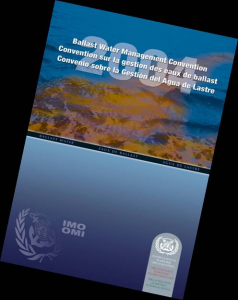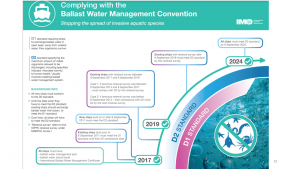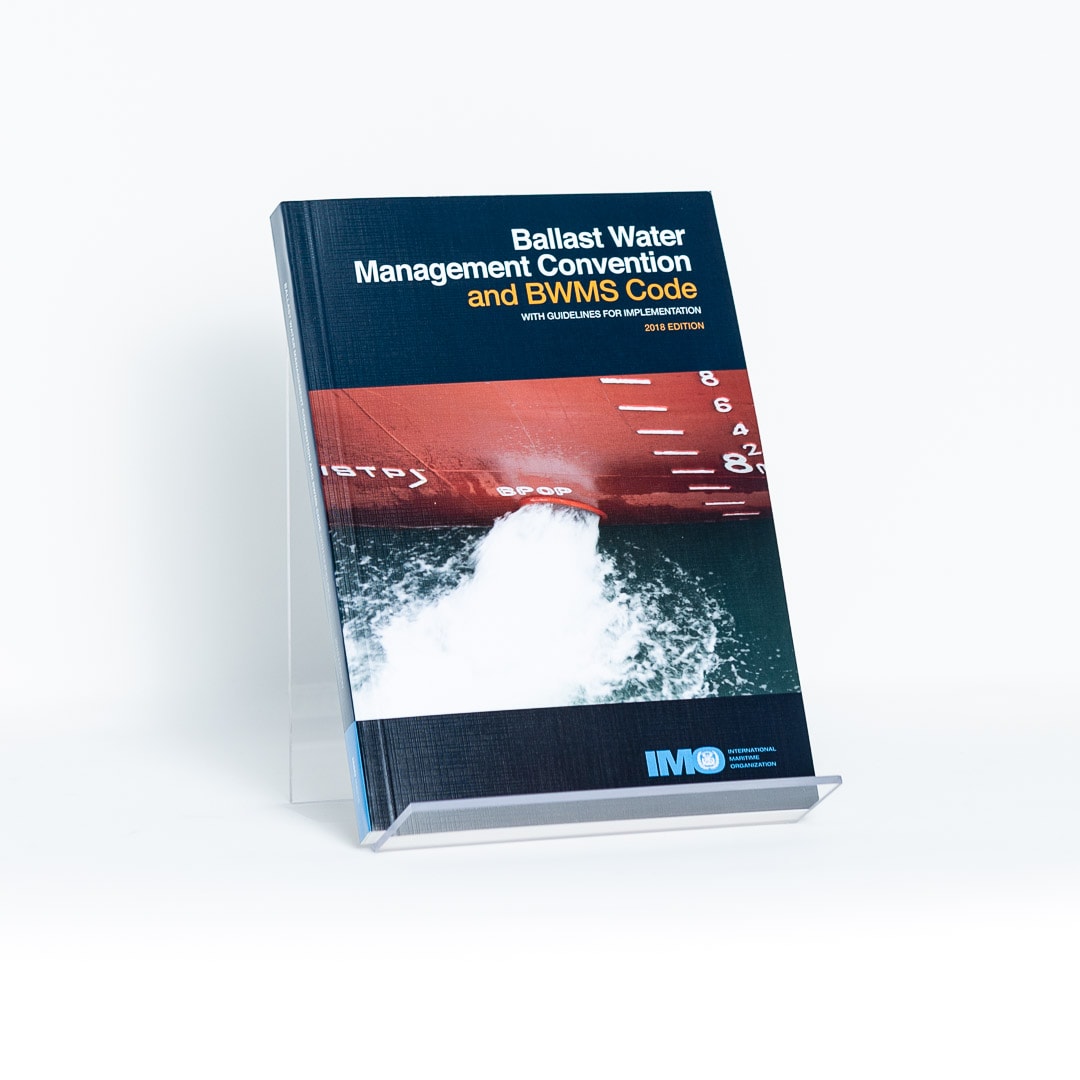Since the introduction of steel-hulled vessels, water has been used as ballast to stabilize vessels at sea. Ballast water is pumped in to maintain safe operating conditions throughout a voyage. This practice reduces stress on the hull, provides transverse stability, improves propulsion and manoeuvrability, and compensates for weight changes in various cargo load levels and due to fuel and water consumption.
While ballast water is essential for safe and efficient modern shipping operations, it may pose serious ecological, economic and health problems due to the multitude of marine species carried in ships’ ballast water. These include bacteria, microbes, small invertebrates, eggs, cysts and larvae of various species. The transferred species may survive to establish a reproductive population in the host environment, becoming invasive, out-competing native species and multiplying into pest proportions.
The problem of invasive species in ships’ ballast water is largely due to the expanded trade and traffic volume over the last few decades and, since the volumes of seaborne trade continue to increase, the problem may not yet have reached its peak yet. The effects in many areas of the world have been devastating. Quantitative data show that the rate of bio-invasions is continuing to increase at an alarming rate and new areas are being invaded all the time.
 After more than 14 years of complex negotiations between IMO Member States, the International Convention for the Control and Management of Ships’ Ballast Water and Sediments (BWM Convention) was adopted by consensus at a Diplomatic Conference held at IMO Headquarters in London on 13 February 2004.
After more than 14 years of complex negotiations between IMO Member States, the International Convention for the Control and Management of Ships’ Ballast Water and Sediments (BWM Convention) was adopted by consensus at a Diplomatic Conference held at IMO Headquarters in London on 13 February 2004.
The Convention requires all ships to implement a ballast water management plan. All ships have to carry a ballast water record book and are required to carry out ballast water management procedures to a given standard. Parties to the Convention are given the option to take additional measures which are subject to criteria set out in the Convention and to IMO guidelines.
Several articles and regulations of the BWM Convention refer to guidelines to be developed by the Organization and Conference resolution 1 invited IMO to develop these guidelines as a matter of urgency and adopt them as soon as practicable and, in any case, before the entry into force of the Convention, with a view to facilitate global and uniform implementation of the instrument.
Implementing the Ballast Water Management Convention
The BWM Convention entered into force on 8 September 2017.
The adoption of all the required Guidelines for the uniform implementation of the BWM Convention and the approval and certification of modern ballast water treatment technologies have removed the major barriers to the ratification of the instrument and a number of additional countries have indicated their intention to accede to this Convention in the near future.
Ballast water management – the control of harmful invasive species
Ballast water may be taken onboard by ships for stability and can contain thousands of aquatic or marine microbes, plants and animals, which are then carried across the globe. Untreated ballast water released at the ship’s destination could introduce a new invasive marine species. Hundreds of such invasions have already occurred, sometimes devastatingly affecting the local ecosystem.
Invasive species – a few examples

Asian Kelp (Undaria pinnatifida)
Better known as wakame, this edible seaweed is commonly used in Japanese and Korean cuisine. While native to cold-water coastal areas of Japan, Korea, and China, it has found its way to New Zealand, France, Great Britain, Spain, Italy, Argentina, Australia, Mexico and the US, where aggressive measures are underway to remove the plant from harbours on the western seaboard. The kelp was discovered in San Francisco Bay in May 2009.
European Green Crab (Carcinus maenas)
Another species colonising Australia is the European green crab, which has found its way from its original habitat in the north-east Atlantic Ocean and Baltic Sea to the Antipodes, South Africa, South America and the Atlantic and Pacific coasts of North America. The green crab is a carnivore that preys upon clams, mussels, oysters, and gastropods. Its introduction to the US in the 1950s has cost the American fishing industry millions of dollars because the green crab preys on scallops and other commercially important shellfish. Aside from preying on native species, the European green crab is able to outcompete them for food, and can reproduce in high volumes. Research suggests that the green crab’s colonisation of estuaries in Washington, Oregon and British Columbia was facilitated by the El Niño storms of 1997 and 1998.
The International Convention for the Control and Management of Ships’ Ballast Water and Sediments (BWM Convention) was adopted in 2004 to introduce global regulations to control the transfer of potentially invasive species. With the treaty now in force, ships need to manage their ballast water. Under the Convention, all ships in international traffic must manage their ballast water and sediments to a certain standard, according to a ship-specific ballast water management plan. All ships have to carry a ballast water record book and an international ballast water management certificate. The ballast water management standards are being phased in over a period of time. New ships must meet the ballast water treatment standard. Existing ships should exchange ballast water mid-ocean but they will need to meet the ballast water treatment standard by the date of a specified renewal survey. Eventually, most ships will need to install an onboard ballast water treatment system.
–
Approval of BWM systems
The BWM Convention requires that ballast water management systems used, to comply with the Convention, must be approved by the Administration taking into account the Guidelines for approval of ballast water management systems (G8).

–
The BWMS Code and effect on BWMS type approval
The BWMS Code was adopted by MEPC 72 and states that all BWMS that have a type approval according to the “old” G8 Guidelines adopted by Res. MEPC.174(58) may be installed on board a ship until 28 October 2020 . Later installations, on or after 28 October 2020, shall comply with the Res. MEPC.279(70) or the BWMS Code adopted by Res. MEPC.300(72) and shall have a type approval accordingly.
This table summarizes the type approval references and the applicable installation due dates:
| Type approval | Due date for installation |
|---|---|
| MEPC.174(58), ‘old’ Guidelines (G8) | Prior to 28 October 2020 |
| MEPC.279(70), 2016 Guidelines (G8) | On or after 28 October 2020 |
| MEPC.300(72), BWMS Code | On or after 28 October 2020 |
For conversions “installed” means the contractual date of delivery of the BWMS to the ship. In the absence of such a date, the word “installed” means the actual date of delivery of the ballast water management system to the ship. The reference for this definition is provided in BWM.2/Circ.66 Rev 1.
In case of doubts regarding the applicable installation date of a BWMS, please inform DNV GL by using our DATE service. This should be done in due time before installation of the BWMS and provided with appropriate documentation confirming the installation date.
–
BWMS Code and documentation to be on board
The following documentation should be verified to be onboard as a precondition to issuing the IBWM certificate:
- A copy of the Type Approval Certificate (TAC) of the BWMS
- Operation, Maintenance and Safety manual of the BWMS
- BWM plan
- Installation specifications, e.g. installation drawing, piping and instrumentation diagrams
- Installation commissioning procedures
–
Frequently asked Questions about BWM Convention
What is the Ballast Water Management Convention?
The Ballast Water Management Convention or BWM Convention (full name International Convention for the Control and Management of Ships’ Ballast Water and Sediments, 2004) is a treaty adopted by the International Maritime Organization (IMO) in order to help prevent the spread of potentially harmful aquatic organisms and pathogens in ships’ ballast water. From 8 September 2017, ships must manage their ballast water so that aquatic organisms and pathogens are removed or rendered harmless before the ballast water is released into a new location. This will help prevent the spread of invasive species as well as potentially harmful pathogens. IMO is the United Nations specialized agency with responsibility for developing global standards for ship safety and security and for the protection of the marine environment and the atmosphere from any harmful impacts of shipping.
When did the BWM Convention enter into force?
The BWM Convention entered into force globally on 8 September 2017.
Which ships does the convention apply to?
The convention applies to ships registered under contracting Parties to the BWM Convention, which take up and use ballast water during international voyages.
What about ships registered under a flag which hasn’t ratified the BWM Convention?
Such ships may not be issued with the relevant certificates. However, port States which are Parties will expect the ships to comply with the requirements of the Convention, so as to ensure no more favourable treatment is given to such ships.
What do ships need to do, now the treaty is in force?
From the date of entry into force, ships in international traffic are required to manage their ballast water and sediments to a certain standard, according to a ship-specific ballast water management plan. Ships have to carry:
A ballast water management plan – specific to each ship, the ballast water management plan includes a detailed description of the actions to be taken to
implement the ballast water management requirements and supplemental ballast water management practices;
A ballast water record book – to record when ballast water is taken on board; circulated or treated for ballast water management purposes; and discharged into the sea. It should also record when ballast water is discharged to a reception facility and accidental or other exceptional discharges of ballast water; and
An International Ballast Water Management Certificate (ships of 400 gt and above)– this is issued by or on behalf of the Administration (flag State) and certifies that the ship carries out ballast water management in accordance with the BWM Convention and specifies which standard the ship is complying with, as well as the date of expiry of the Certificate.
What are the ballast water management standards?
There are two ballast water management standards (D-1 and D-2). The D-1 standard requires ships to exchange their ballast water in open seas, away from coastal areas. Ideally, this means at least 200 nautical miles from land and in water at least 200 metres deep. By doing this, fewer organisms will survive and so ships will be less likely to introduce potentially harmful species when they release the ballast water. The D-2 standard specifies the maximum amount of viable organisms allowed to be discharged, including specified indicator microbes harmful to human health. From the date of entry into force of the BWM Convention, all ships must conform to at least the D-1 standard; and all new ships, to the D-2 standard. Eventually, all ships will have to conform to the D-2 standard. For most ships, this involves installing special equipment to treat the ballast water. IMO Member Governments, meeting in the Marine Environment Protection Committee (MEPC), have agreed an implementation timetable for existing ships, linked to the ship’s International Oil Pollution Prevention Certificate (IOPPC) renewal survey.
What does the new schedule for implementation say?
In essence, the schedule for implementation which has been agreed by the MEPC means that compliance with the D-2 standard will be phased in over time for individual ships, up to 8 September 2024. Over time, more and more ships will be compliant with the D-2 standard. (See the infographic above). From 8 September 2017:
New ships must meet the D-2 standard.
All ships must have: – A ballast water management plan; – A ballast water record book; and – An International Ballast Water Management Certificate.
Existing ships must meet at least the D-1 (ballast water exchange) standard; they may also choose to install a ballast water management system or otherwise meet the D-2 (discharge) standard but this is not mandatory until the corresponding compliance date.
IOPPC Renewal survey after 8 September 2019 A ship undergoing a renewal survey linked to the ship’s International Oil Pollution
Prevention Certificate after 8 September 2019 will need to meet the D-2 standard by the date of this renewal survey.
IOPPC Renewal survey between 8 September 2017 and 8 September 2019 – If the previous IOPPC renewal survey was between 8 September 2014 and 8
September 2017, then the ship must comply with D-2 standard by this renewal survey. – If the previous IOPPC renewal survey was before 8 September 2014, then the ship can wait until the next renewal survey (which is after 8 September 2019).
What if the ship doesn’t have an IOPPC renewal survey?
The ship should meet the D-2 standard at a date determined by its flag State, but not later than 8 September 2024.
What is the real difference between the D-1 and D-2 standards?
The difference is that D-1 relates to ballast water exchange, while D-2 specifies the maximum amount of viable organisms allowed to be discharged, including specified indicator microbes harmful to human health.
D-1 standard : The D-1 standard requires ships to conduct an exchange of ballast water such that at least 95% of water by volume is exchanged far away from the coast.
D-2 standard: The D-2 standard specifies that ships can only discharge ballast water that meets the following criteria:
less than 10 viable organisms per cubic metre which are greater than or equal to 50 micrometres in minimum dimension;
less than 10 viable organisms per millilitre which are between 10 micrometres and 50 micrometres in minimum dimension;
less than 1 colony-forming unit (cfu) per 100 mililitres of Toxicogenic Vibrio cholerae;
less than 250 cfu per 100 millilitres of Escherichia coli; and
less than 100 cfu per 100 milliliters of Intestinal Enterococci.
How will ships’ compliance be checked?
Ships may be subject to port State control in any port or offshore terminal of a Party to the BWM Convention. This inspection may include verifying that there is onboard a valid Certificate and an approved ballast water management plan; inspection of the ballast water record book; and/or sampling of the ship’s ballast water, carried out in accordance with the Guidelines for ballast water sampling (G2). However, the time required to analyse the samples shall not be used as a basis for unduly delaying the ship’s operation, movement or departure.
How are ballast water management systems approved?
Regulation D-3 of the Convention covers approval requirements for ballast water management systems. Ballast water management systems must be approved by the Administration, considering IMO Guidelines. Revised Guidelines for approval of ballast water management systems (G8) were adopted in 2016 and have now been reworked as a draft mandatory Code for approval of ballast water management systems (BWMS Code), expected to be adopted by MEPC 72 in April 2018. The BWMS Code includes robust test and performance specifications as well as detailed requirements for type approval reporting and control and monitoring equipment. Ballast water management systems which make use of Active Substances or preparations containing one or more Active Substances must, in addition be approved by IMO, in accordance with the Procedure for approval of ballast water management systems that make use of Active Substances (G9).
Has the BWM Convention implementation been delayed by IMO?
When the BWM treaty was adopted in 2004 it was envisaged that there would be a phase-in of the D-2 standard (ballast water performance standard). IMO, Member States adopted the treaty with a number of dates included, such as referring to ships constructed before 2009, 2012 and 2016. However, these dates were reached before the treaty achieved sufficient ratifications to meet entry into force criteria. So IMO Member Governments, recognizing this, agreed that when the treaty did enter into force, there would be a phase-in – as envisaged by the original treaty, but with dates that would not be obsolete. So this has been a pragmatic way to address the fact that the original dates contained in the treaty would inevitably be overtaken, once it became clear that the ratifications needed to meet entry into force criteria would take several years and go beyond those dates. It is important to recognize that entry into force of the treaty means that certain requirements, including ballast water management for all ships and the D-2 standard for new ships, are now in force.
Will there be any further amendments later on?
The MEPC has recognized that challenges may be expected with the entry into force of an entirely new treaty. There may be a need for future improvements to the BWM Convention in light of the experience gained. MEPC 71 adopted an important MEPC resolution, on “the experience-building phase associated with the BWM Convention”. This envisages a three-stage approach – data gathering; data analysis; and Convention review. Based on the experience and feedback gained, as well as the analysis of the data gathered, draft amendments to the Convention consideration at MEPC 79 (in 2022). As with other international treaties, Parties may propose individual amendments at any time.
Source: IMO
- IMO Circular Letter No.4204/Add.1 (PDF)
- IMO Circular Letter No.4204/Add.7 (PDF)
- IMO Circular Letter No.4204/Add.19 (PDF)

